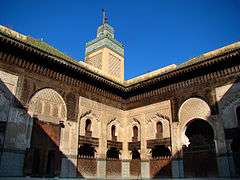Abu al-Hassan Mosque
The Mosque of Abu al-Hassan is a neighbourhood mosque in Fes el-Bali, the old medina of Fes, Morocco. It is located on Tala'a Sghira street, near the Bou Inania Madrasa.[1] It was built in 1341 by the Marinid sultan Abu al-Hassan.[2][3][4]
| Abu el-Hassan Mosque | |
|---|---|
 The minaret of the mosque, seen from Tala'a Sghira street. | |
| Religion | |
| Affiliation | (Maliki) Sunni Islam |
| Status | active |
| Location | |
| Location | Fes, Morocco |
| Geographic coordinates | 34°03′43.2″N 4°58′56.2″W |
| Architecture | |
| Type | mosque |
| Style | Marinid, Moroccan, Islamic |
| Founder | Abu al-Hassan |
| Completed | 1341 |
| Specifications | |
| Length | 10.35 metres |
| Width | 17 metres |
| Minaret(s) | 1 |
| Minaret height | (approx.) 18.85 metres |
Architecture
Description
The mosque is a generally rectangular building 17 metres wide and 10.35 metres deep.[3] The mosque's street facade is marked by a doorway in the shape of a horseshoe arch, which is overshadowed by an ornately-carved wooden canopy.[3]
The interior layout of the mosque features a small square courtyard flanked by galleries on two sides and by the main prayer hall to the south. Somewhat unusually, the prayer hall is composed of only one transverse "nave" running along the full width of the building instead of being split by multiple rows of arches.[3] The prayer hall is covered by a sloped timber roof and a wooden ceiling with painted decoration.[3] Another small courtyard, connected to the mosque by a passage off the main courtyard, includes a water basin for performing ablutions.[3]
The mosque's minaret, which rises above the entrance, has a typical Moroccan form with a square shaft. Each of the minaret's four facades is decorated with either a sebka pattern (roughly resembling a fleur-de-lys motif) or another interlacing geometric pattern above another radiating arch motif at its base.[4] The empty spaces within the motifs of each facade are filled with zellij mosaic tilework, and a band of zellij also runs near the top of the minaret's shaft. While the geometric patterns may date from the Marinid period, the zellij tilework may have been added around the late 18th or early 19th century during the Alaouite period.[4] The minaret's design bears resemblances with the Chrabliyine Mosque which was built around the same time.[4]
Gallery
 The entrance of the mosque (in 1932).
The entrance of the mosque (in 1932)..jpg) Details of the ornately-carved wooden canopy above the mosque's entrance (today).
Details of the ornately-carved wooden canopy above the mosque's entrance (today)..jpg) The northern facade of the minaret (on the street side).
The northern facade of the minaret (on the street side).
See also
References
- Le Tourneau, Roger (1949). Fès avant le protectorat : étude économique et sociale d'une ville de l'occident musulman. Casablanca: Société Marocaine de Librairie et d'Édition. p. 71.
- Métalsi, Mohamed (2003). Fès: La ville essentielle. Paris: ACR Édition Internationale. p. 188. ISBN 978-2867701528.
- Marçais, Georges (1954). L'architecture musulmane d'Occident. Paris: Arts et métiers graphiques. p. 277.
- Lintz, Yannick; Déléry, Claire; Tuil Leonetti, Bulle (2014). Le Maroc médiéval: Un empire de l'Afrique à l'Espagne. Paris: Louvre éditions. ISBN 9782350314907.
| Wikimedia Commons has media related to Abu al-Hasan Mosque. |

